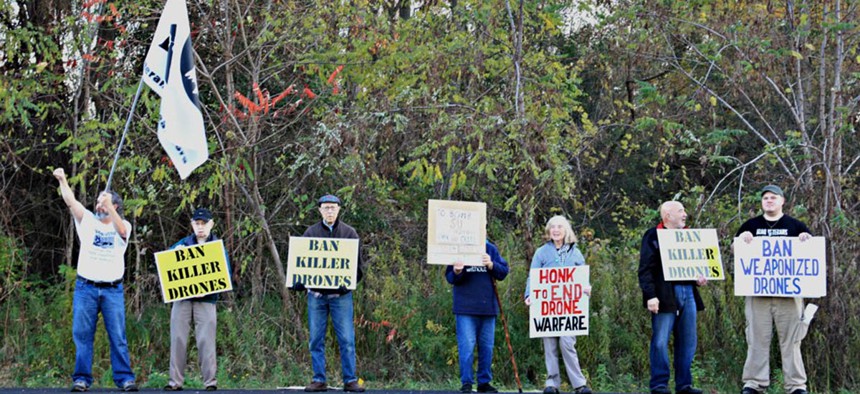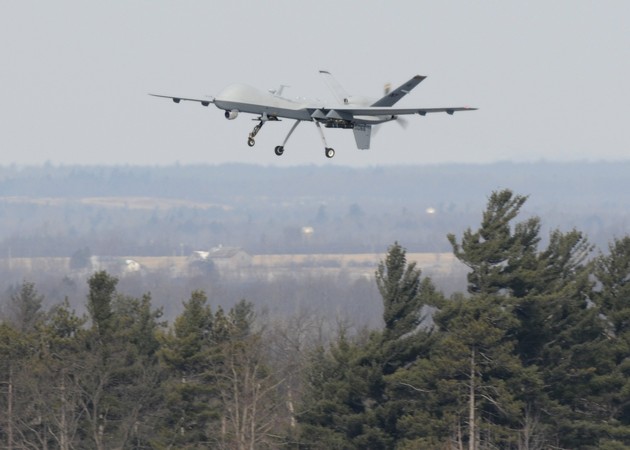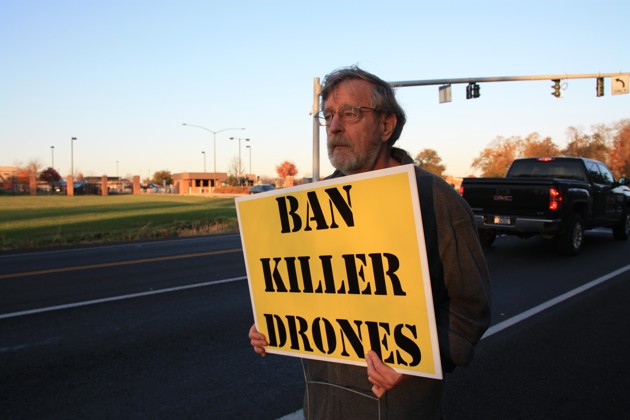Community Rallies to 'Ban Killer Drones'

Alana Semuels
The unmanned-aircraft industry could help to revive a struggling region. But what are the consequences?
SYRACUSE—Every other Tuesday, a small crowd forms across the street from the Hancock Air National Guard base here, a few hundred yards from where big letters proclaim this the home of the 174th Attack Wing. They are protesting the National Guard troops on the base, who control the Reaper drones used in military operations overseas.
“Ban Killer Drones,” their signs say, and the protesters wave them as cars rush by on a busy road.
“It’s murder by remote control,” Jason Sperry, a 33-year-old veteran from Syracuse, explained when I asked him why he was protesting.
Opponents have long had qualms about the use of drones in battle, but now activists in central New York have something else to worry about. The region is trying to make itself a hub for drone technology, seeking federal and state money to expand the range of companies that research and build unmanned aircraft and the devices that allow them to communicate with each other.
It’s a proposal that makes some uneasy in this liberal area of a liberal state, as they worry that as the nation becomes more accustomed to drones—and more economically dependent on that industry—fewer people will oppose their use in war and in commercial applications that intrude upon Americans’ privacy.
“There’s a lot of effort to make central and upstate New York a drone hub,” said Ed Kinane, an activist with the Upstate Drone Action Coalition, as he stood outside the base on a warm fall day. “But I think it’s very unfortunate that people’s jobs are tied in with assassination and surveillance.”
Already, Saab Sensis, which is based in East Syracuse, makes military radars and air-traffic management systems; Lockheed Martin builds electronics warfare in Salina, a suburb of Syracuse (the company is Onondaga County’s largest for-profit employer); and SRC Inc. designs and builds radars and sensors for both military and commercial applications.
New companies and degree programs in drone technology are being added every month. A company that trains aerial-drone pilots started offering classes in central New York this summer. Pro Drones, an offshoot of a Canadian company,said in September it was setting up shop in Rome, New York. A New York City-based company said it would start testing its agricultural drone technology in central New York. A Texas company spent the past summer in Syracuse developing technology to aerially measure roofs for solar panels.

Efforts to make central and upstate New York a drone hub really got going after Congress passed the FAA Modernization and Reform Act in 2012, which directed the FAA to integrate unmanned aircraft into the U.S. airspace. As part of that bill, the FAA chose six test sites across the country where the industry could research how to safely fly drones in commercial airspace.
The UAS test sites, as they’re called, for Unmanned Aircraft System, are centered in Alaska, Nevada, North Dakota, Texas, Virginia, and New York, at Griffiss International Airport, about 50 miles east of Syracuse.
“Through Congressional action, the FAA has finally begun to move and what that has done has really set off a feeding frenzy, if you will, in the whole unmanned-systems industry,” said Larry Brinker, the executive director of the NUAIR Alliance, a coalition of private companies and universities based at Griffiss International Airport that is leading the effort to expand the UAS industry in the region.
Central New York is appealing to companies because it offers four seasons in which to test drones, Brinker said, as well as the opportunity to fly in both the empty acres of air space of rural New York state and the crowded corridors of commercial air space in the Northeast. It also has dozens of universities, which can house research related to drone technology, he said.
NUAIR is hoping to attract an even bigger piece of that industry by winning half a billion dollars from the state of New York through Governor Andrew Cuomo’s Upstate Revitalization Initiative. Regions across the state are competing in the initiative, which in December will award three regions $100 million a year for five years for economic-development projects.
Central New York’s pitch centers around Unmanned Aircraft Systems, and the region has pledged to put half of the money it is awarded—$250 million—to “leverage our region’s remarkable assets in precision-sensing and data analytics to become the global leader in unmanned systems.”
Under any circumstance $250 million is a lot of money, but in an economically depressed region such as central New York, it would be a windfall. Most drone-testing sites have been able to secure investments of $10 million or so; $250 million would place central New York at the front of the pack, Brinker said.
If central New York wins the contract, Brinker said, NASA has pledged to build a facility in the region to test the reliability of various drones.
NUAIR argues that investing money to make central New York a drone-testing hub could help resuscitate a region sorely in need of a turnaround. The city of Syracuse had an unemployment rate of 5.1 percent in September, and the city has some of the worst urban poverty in the country.

For decades, the job news here has been about factories closing and jobs being lost. Winning more money to expand the drone industry could reverse that, Brinker told me.
“We want to plant our flag for the future, to say, if you want to develop a UAS, if you want to test your UAS for commercial purposes, you have to come to Central New York. This is where that's happening,” he said. “It's like the Silicon Valley for startups, right? That's what we're trying to build here.”
Many of the anti-drone protesters agree that the region needs jobs. But they argue that the jobs created by the expanding drone industry won’t help Syracuse, where only one-fourth of the population has a bachelor’s degree or higher. The jobs will be for engineers and for computer scientists who will be imported from elsewhere.
“It’s not going to produce jobs for a Syracusan. It’s all high-tech engineer jobs, and for that you need a high-tech education,” said Dave Kashmer, a protester and U.S. Navy veteran.
Activists would like to see more privacy regulations before drones are embraced anywhere. They argue that they money spent on growing the drone industry could be used on infrastructure or renewable energy or other things that also bring jobs.
“Of course you can sell anything if it’s going to bring jobs and money, and this is an area that's really depressed,” Ann Tiffany, another protester, told me. “I do think there are good uses for drones, but using them for commercial purposes can morph into privacy issues and surveillance. It’s very hard to legislate and control drones.”
Tiffany was the driving force behind a resolution passed in Syracuse in 2013 prohibiting police or other city agencies from using drones until privacy regulations were put in place. It was the fifth city in the country to pass this type of legislation.
But the resolution doesn’t stop the military or private companies from testing drones in the region, something that became obvious to residents when operators lost control of a small military drone in July that had launched from Lockheed’s Owego facility. And in November 2013, a MQ-9 Reaper drone suffered a software error and crashed into Lake Ontario after taking off from a base in Fort Drum, further upstate.
Carol Baum, another activist, says there’s another way that drones are out of control: They can fly above and collect all sorts of information, and there aren’t yet any regulations on what they do with that information. Indeed, California is one of the only states that have passed legislation about what drones can record when they fly over private airspace (like a celebrity’s home), but enforcing that law isn’t easy.
“The technology has outstripped laws to protect us,” Baum told me. “Pretty much anybody right now can put a camera on a drone and fly it over our backyard. There’s a lot of potential misuse of that information.”
Many people—including Kanye—have spoken out about their fears of wayward drones, but Kinane worries that as drones become more commonplace in delivering goods, putting out fires, and looking for lost people, the nation will become more apathetic to the times they’re used for surveillance.
“I think once the drones are normalized then you bring them home and who are the targets? They’re going to be dissenters, they’re going to be demonstrators, they’re going to be minorities,” he said. “It doesn’t bode well.”
Brinker, of NUAIR, says many Americans he talks to are already getting more comfortable with the technology. This could help him win his bid to expand the industry in the region, despite Kinane and others’ protests.
“What's happened when I go out and talk to the public, instead of getting a question about privacy or killer drones, I get the, ‘When is the package coming? When is Amazon going to deliver my package?’” he told me. “So, the debate really has shifted significantly.”





